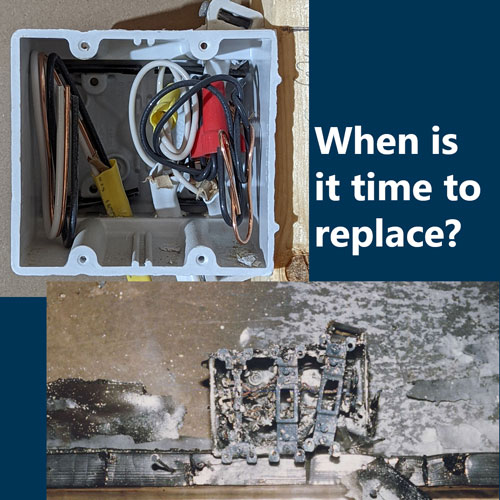
Your house probably has a dozen or more electrical boxes installed throughout the residence. While these boxes last a long time, there are occasions when they need to be replaced, and failing to recognize those times can create safety hazards.
So, let’s take a minute to learn a little more about these enclosures, how to recognize signs of age, when they need replacement, and what you can do about it.
For the most part, we can break electrical boxes into two categories: electrical panels and everything else.
Your Electrical Panel
Your main breaker panel is the one with the switches you can flip to turn off electricity to parts of your house. This is an electrical enclosure, but it’s a bit specialized. In fact, it’s one of the most important safety devices in any home.
These panels are typically designed to last for 30 years or more, so you should see signs of wear before they need a replacement. If you do see any visible signs of damage, then it’s time to call an electrician (it’s illegal in every state to replace these panels without proper certifications).
Other signs of age include flickering lights, discoloration around the panel, and uneven power. If your blender can’t run at a steady RPM, that’s the same warning as lights flickering in every room.
Aside from wear and age, there are times to update your electrical panel for functionality. If you want appliances that need larger power supplies, then you might need an electrician to expand your electrical panel (and run wires) to accommodate that need.
In short, update your electrical panel if you see signs of wear or if electricity demands necessitate it.
Other Electrical Boxes
Aside from your electrical panel, you have an electrical enclosure for every light switch and outlet in the house. Each has its own box, and each box should be assessed independently.
In the vast majority of cases, these boxes are recessed behind your drywall, so you won’t be able to see signs of wear on the box itself. That’s ok because signs of wear will appear on the things attached to the box. For instance, electrical outlets and light switches are prone to discoloration if your electrical box ages too much.
These boxes are designed to last for 20 years or more, so you don’t need to do weekly inspections. But aside from discoloration, any obvious signs of damage are worth noting. That includes cracks, burn marks, or anything else you might see around your outlets and switches.
Like your electrical panel, these boxes need updates sometimes too. If building codes change in your area, you might not be legally obligated to update the boxes, but it could be worth considering for better safety and longevity.
On a different note, if you want to expand outlet or switch access, you may need larger electrical boxes to accommodate the extra stuff. Once again, you’ll need an electrician to ensure that the work is up to code.
Looking to stay up-to-date on the latest articles and product releases? Don’t miss out – sign up below and be the first to know!
